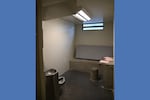The state of Washington defines “solitary confinement” as when an incarcerated person is confined to a cell alone, for more than 20 hours a day.
“The stressful part is, there’s nothing you can do about nothing. You’re forced to just sit there and think and think and think — the lights are on 24/7 making it hard for you to sleep,” said Charles Longshore, who is incarcerated at Airway Heights Correction Center near Spokane.
Longshore says more than half of the time he's served in prison so far has been in isolation.

This provided photo shows a solitary confinement cell at Washington's Monroe Correctional Complex.
Washington Department Of Corrections
He was last put in solitary several years ago, but he says he’s still antisocial and timid around other people. He says it’s vital that incarcerated people who are in isolation get more mental, physical and sensory relief — especially during the limited time they get outside of a cell. At Airway Heights, he describes the area people go to for yard time as “a small little cage.”
"We need activities in there for them to do," Longshore said. "If you isolate them, segregate them and deprive them of the basic necessities, what meaningful help are you providing that person? What are you teaching that person? And how is that deterring future conduct?"
Washington’s Department of Corrections announced in January that it aims to reduce solitary confinement by 90%. A plan unveiled last week says it will take five years to meet that goal. According to that report, about 5% of the prison population in Washington was in solitary confinement in January, or about 680 people.
Corrections’ plan points to several ways to not just reduce the use of solitary but to sustain that reduction — including staff training, alternatives to solitary, and providing more support programs for inmates. It also highlights various projects to add more program space near segregation units and to make other changes to the facilities themselves. The department says moving forward with solitary reforms relies on whether lawmakers provide $228 million to pay for them.
Longshore is glad there are plans to limit the use of isolation, but is among many advocates who want to see the use of solitary confinement eliminated completely. Rachael Seevers, an attorney with Disability Rights Washington, says even a five-year timeline to reduce its use is too long.
"This is something that [Department of Corrections] has been talking about and looking at for years, and it's time that they move quickly," Seevers said. "This is a problem that we have created from our behaviors over the past decades, and it is absolutely something that we have a moral obligation to fix."
While there has been progress on reducing the use of isolating conditions in Washington's prisons, understanding the way solitary confinement is used can be complicated, as officials refer to isolated housing conditions in several different ways.
According to a 2022 report from Disability Rights Washington, the overall population in Washington's prisons dropped by roughly 27% since 2018, but the use of one type of solitary confinement, administrative segregation, decreased by just 3% in the same time frame.
The department defines administrative segregation as a placement for an incarcerated person who poses a significant risk to staff or other prisoners, until “a decision can be made about appropriate housing.” But some people in protective custody, seeking health services, or those with serious mental illness — including those at risk of self harm or suicide — have also been subjected to harmfully isolating conditions, according to Disability Rights Washington. Corrections announced in 2021 it would stop using segregation for disciplinary reasons.
Data from Corrections shows that of the 1,558 people who exited administrative segregation earlier this year, a vast majority were there for two to three weeks on average. Meanwhile, 83 of those people were there between two to three months.
A bill in the Legislature earlier this year would have placed new rules and limits on solitary confinement, but the bill died in a committee. It’s up for review again next year. Seevers says the measure would "complement" the plan just released by Corrections, but would also require changes on a quicker timeline.
Seevers says it’s critical for lawmakers to pass the bill this year so the department is required to follow through on its plans and has accountability for how it uses any potential funding — even when new leadership oversees the department. Corrections Secretary Cheryl Strange told TVW in September that she’d like to leave the position once Gov. Jay Inslee finishes his current term.
Still, the department’s plan hinges on whether lawmakers throw their support behind it. The department says it will move forward with solitary reform only after lawmakers provide funding to pay for it — possibly next year.